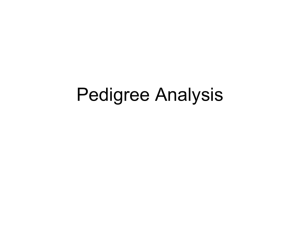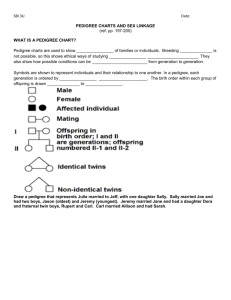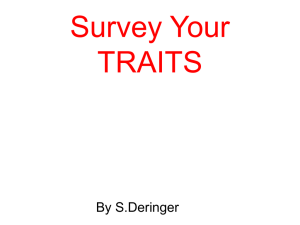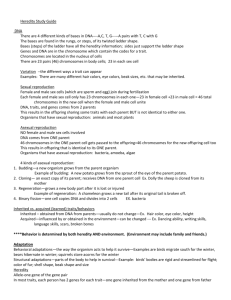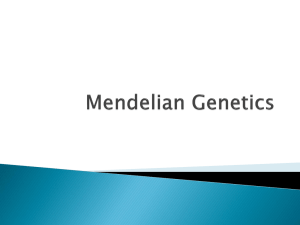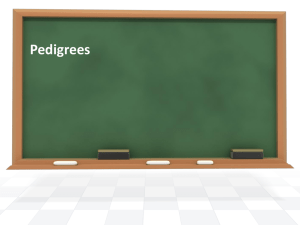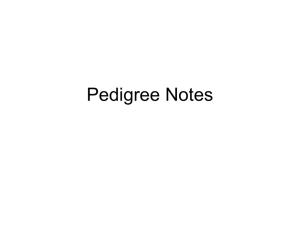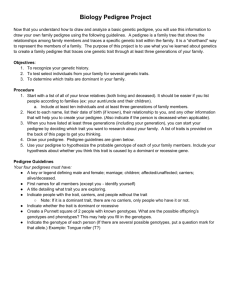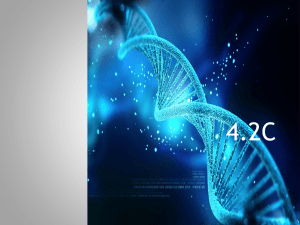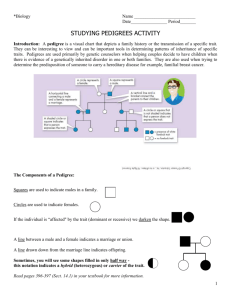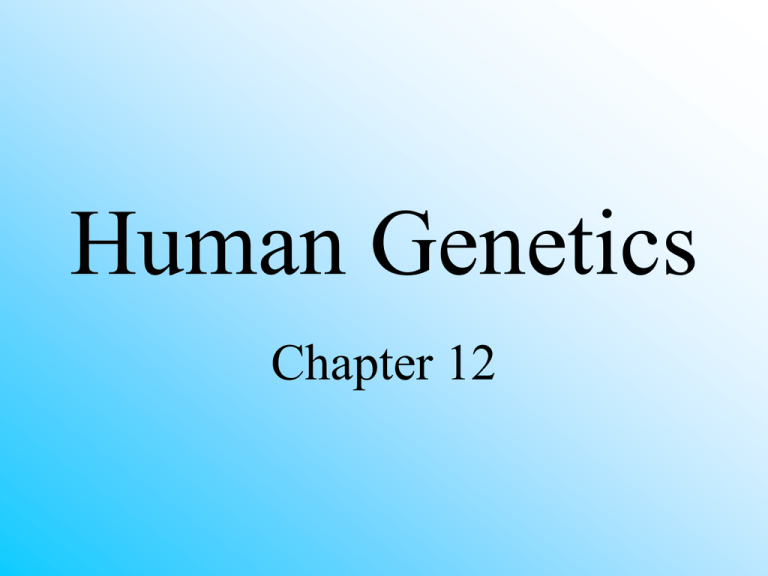
Human Genetics
Chapter 12
Human Genetic Traits
• Do you think this trait is dominant or
recessive?
Widow’s Peak?
DOMINANT
PTC Tasting
• Can you taste the PTC????
• DOMINANT
Earlobe Shape?
• Is your earlobe attached?
• Do you think this trait is dominant or
recessive?
RECESSIVE
Dimples?
DOMINANT
Human Inheritance
• Humans - 23 pairs of chromosomes
– These are made of about 100,000 genes
• Scientists study disease causing genes
because they can easily be traced
– Pedigree – a family record that shows how a
trait is inherited over several generations.
Pedigree
A Pedigree of Hemophilia in the Royal Families of Europe
Pedigree
page 299
• Carriers – usually, Heterozygous
-do not express the recessive allele, but pass
it to their offspring
Square = Male
Circle = Female
No shading = normal
Shaded = displays trait
Half/Half = Carrier
Pedigree Practice
• Construct a family pedigree of two
unaffected parents with a child who suffers
from cystic fibrosis.
Pedigree Practice
• Suppose both parents can roll their tongues
but their son cannot. Draw a pedigree
showing this trait, and label each symbol
with the appropriate genotype.
Pedigree Practice
• Describe the pedigree of a boy who has
galactosemia. His father has galactosemia,
his paternal grandparents are phenotypically
normal. His mother and maternal
grandparents are both phenotypically
normal.
• A boy is an albino. His mother is also an
albino. His father is phenotypically normal.
However, his paternal grandfather is an
albino. The other 3 of his grandparents are
phenotypically normal.
• A brother and a sister both are hemophilic.
Neither parent shows this trait, however the
maternal grandmother suffers from this
disorder. The other grandparents are
phenotypically normal.
On Your Own
• Page 300
• Mini Lab 11.1 – Investigate Human
Pedigrees
Simple Dominant Heredity
• Many traits are inherited just as the rule of
dominance predicts.
• Remember, in Mendelian inheritance, a
single dominant allele inherited from 1
parent is all that is needed for a person to
show the dominant trait.
Patterns of Inheritance
• Traits controlled by a Single Allele
– >200 traits are determined by a single dominant allele
• Ex. Huntington’s Disease
– >250 other traits are determined by homozygous
recessive alleles
• Ex. Cystic Fibrosis, PKU, blue
people in Eastern Kentucky
Sometimes Heredity Follows Different Rules
1. Incomplete Dominance: Appearance of a third
phenotype
2. Sex-linked inheritance
3. Codominance: Expression of
both alleles
1. Incomplete Dominance
• Incomplete dominance - Cross
between organisms with 2
different phenotypes
-produces offspring with a 3rd
phenotype that is a blending of
the parental traits.
– RED Flower x WHITE Flower --> PINK Flower
• R = allele for red flowers
W = allele for white flowers
red x white ---> pink
RR x WW ---> 100% RW
2. Sex determination
• In humans, the diploid number of
chromosomes = 46 (23 pairs)
– There are 22 matching pairs of homologous
chromosomes called autosomes.
– The 23rd pair differs in males and females, they
determine the sex of an individual (sex chromosomes)
• X females (XX)
• Y males (XY)
*Complete a punnett square to determine the expected ratio
of males to females produced given their possible
gamete contribution
Sex-linked inheritance
• Traits controlled by genes located on sex
chromosomes are called sex-linked traits
• Sex-Linked Traits are found only on the X
chromosome
– Ex. Hemophilia (recessive)
– Ex. Patterned Baldness
• Homozygous baldness-both will lose hair
• Heterozygous-men will lose hair but women will not
– Ex. Colorblindness (recessive)
Color Blindness Activty
• http://colorvisiontesting.com/ishihara.htm
• http://colorvisiontesting.com/online%20test.htm
• Draw your family pedigree for color blindness!
• Predict what your children genotype could be if:
– Boys – you married a woman who carried the trait for
being color blind on her X chromosome
– Girls – you married a man who was color blind
Patterns of Inheritance
• Complete a punnett square to show how the
allele for red eye color is a sex-linked trait
3. Codominance
• Codominance - the "recessive" & "dominant"
traits appear together in the phenotype of
hybrid organisms.
• Example:
red x white ---> red & white spotted
• R = allele for red flowers
W = allele for white flowers
red x white ---> red & white
spotted
RR x WW ---> 100% RW
Examples of Codominance
1. Roan fur in cattle
– Cattle can be:
1. red (RR = all red hairs)
2. white (WW = all white hairs)
3. roan (RW = red & white hairs together)
2. Human blood type: AB
-2 types of protein
("A" & "B") appear together
on the surface of blood cells
– How to determine Blood Types:
– 4 possible blood types (in order from most
common to most rare):
O, A, B and AB.
– O blood type = individual who is homozygous
recessive (ii) and does not have an allele for A or
B.
• Blood types A and B are codominant alleles.
– Recessive allele i (for blood type O) is only
expressed when 2 recessive alleles are present.
– Individuals who have blood type A:
• Genotype = IAIA or IAi
– Individuals who have blood type B:
• Genotype = IBIB or Ibi
– Individual who has blood type AB:
• Genotype = IAIB
– Individual who has blood type O:
• Genotype = ii
Human Blood Types
**IMPORTANCE in Real-Life**
– Blood transfusion can only take place between
2 people who have compatible types of blood.
– Human blood is separated into different
classifications because of the varying proteins
on the surface of blood cells.
– These proteins are there to identify whether or
not the blood in the individual's body is it's own
and not something the immunity system should
destroy.
Blood type practice
Use a Punnett Square!
1. A woman has type
A blood. Her father
has type O blood.
The woman marries
a man with type O
blood. What is the
chance that they
will have a child
with type A blood?
2. What is the chance
that the couple
from question 1 will
have a child with
type AB blood?
*Show me your
answers when you
are finished. Keep
these in your notes!
Sickle Cell Anemia
• Read about
Codominance
on pg. 302-303
• Define
Codominance.
• Explain Sicklecell Disease in
½ page.
• Complete Data
Analysis Lab
11.1 on the
bottom ½ of the
page.
Sickle Cell Anemia
Cont.
• A Mutation Story:
http://www.teachersdo
main.org/resource/tdc
02.sci.life.gen.lp_disor
der/
Nondisjunction
• Nondisjunction is the failure of
homologous chromosome pairs to separate
properly during meiosis. The result of this
error is a cell with an abnormal (too few or
too many) number of chromosomes.
Nondisjunction
Activity: Human Karyotype
Patterns of Inheritance
• Disorders due to Nondisjunction
– Monosomy (45 Chromosomes)
– Trisomy (47 Chromosomes)
» Trisomy-21 (Down Syndrome)
» Trisomy-18 (Edwards Syndrome)
» Trisomy-13 (Patau)
Child with Trisomy 21
Disorders due to Nondisjunction Cont.
– Klinefelter’s (XXY)-male w/ some female
traits
– Turner’s (XO)-female appearance
• Single Y chromosome do not survive
• Typically Sterile
Environmental Effects
• Genes are inherited from parents, but
sometimes their expression is modified by
environmental factors.
• An example is the snowshoe hare we
discussed earlier in the year-these hares
have dark fur in the summer and white fur
in the winter.
Snowshoe Hare
Detecting Human
Genetic Disorders
• Genetic Screening – examination of
genetic makeup
– Karyotype: a picture of chromosomes
grouped in pairs and arranged in
sequence.
– Screening of Blood: look for certain
proteins
• Genetic Counseling-medical guidance
informing of problems that could affect their
offspring.
Detecting Human
Genetic Disorders
– Amniocentesis: removal of small amount
of amnionic fluid surrounding the fetus
– Chorionic Villi Sampling: tissue that
grows between the mother’s uterus and
the placenta (between the 8th and 10th
week)
– Screening Immediately after Birth:
• Ex PKU (Phenylketonuria)-body cannot
metabolize the amino acid phenylalanine
– Special diet lacking phenylalanine
Karyotyping
• http://www.biology.arizona.edu/human_bio/
activities/karyotyping/karyotyping2.html

